Duiker William J., Spielvogel Jackson J. The Essential World History
Подождите немного. Документ загружается.

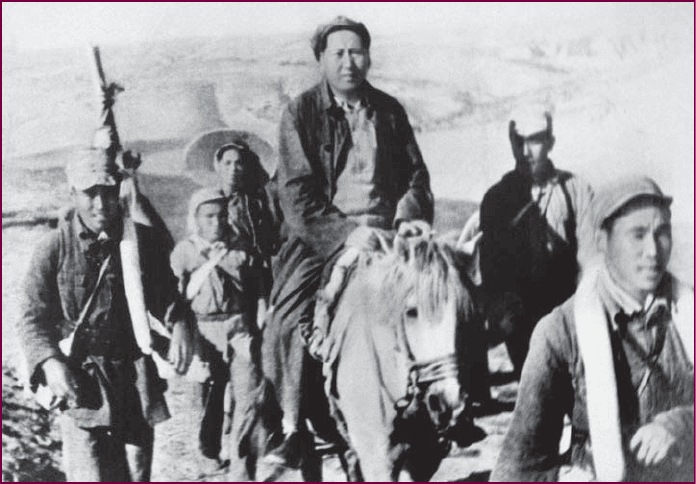
In keeping with Sun’s program, Chiang announced a
period of political indoctrination to prepare the Chinese
people for a final stage of constitutional government. In
the meantime, the Nationalists would use their dictatorial
power to carry out a land reform program and modernize
the urban industrial sector.
But it would take more than paper plans to create a
new China. Years of neglect and civil war had severely
frayed the political, economic, and social fabric of the
nation. There were faint signs of an impending industrial
revolution in the major urban centers, but most of the
people in the countryside, drained by warlord exactions
and civil strife, were still grindingly poor and over-
whelmingly illiterate. A westernized middle class had
begun to emerge in the cities and formed much of the
natural constituency of the Nanjing government. But this
new westernized elite, preoccupied with bourgeois values
of individual advancement and material accumulation,
had few links with the peasants in the countryside or the
rickshaw drivers ‘‘running in this world of suffering,’’ in
the poignant words of a Chinese poet. In an expressive
phrase, some critics dismissed Chiang and his chief fol-
lowers as ‘‘banana Chinese’’---yellow on the outside, white
on the inside.
The Best of East and West Chiang was aware of the
difficulty of introducing exotic foreign ideas into a society
still culturally conservative. While building a modern
industrial sector, he attempted to synthesize modern
Western ideas with traditional Confucian values of hard
work, obedience, and moral integrity. In the officially
promoted New Life Movement, sponsored by his
Wellesley-educated wife, Mei-ling Soong, Chiang sought
to propagate traditional Confucian social ethics such as
integrity, propriety, and righteousness, while rejecting
what he considered the excessive individualism and ma-
terial greed of Western capitalism.
Unfortunately for Chiang, Confucian ideas---at least
in their institutional form---had been widely discredited by
the failure of the traditional system to solve China ’s
growing problems. With only a tenuous hold over the
Chinese provinces, a growing Japanese threat in the north,
and a world suffering from the Great Depression, Chiang
made little progress with his program. Chiang repressed all
opposition and censored free expression, thereby alienat-
ing many intellectuals and political moderates. A land
reform program was enacted in 1930 but had little effect.
Chiang Kai-shek’s government had little more success
in promoting industrial development. During the decade
of precarious peace following the Northern Expedition,
industrial growth averaged only about 1 percent annually.
Much of the national wealth was in the hands of senior
officials and close subordinates of the ruling elite. Mili-
tary expenses consumed half the budget, and distressingly
little was devoted to social and economic development.
The new government, then, had little success in
dealing with China’s deep-seated economic and social
problems. The deadly combination of internal disinte-
gration and foreign pressure now began to coincide with
the virtual collapse of the global economic order during
the Great Depression and the rise of militant political
forces in Japan determined to extend Japanese influence
MaoZedongontheLong
March. In 1934, the Communist leader
Mao Zedong led his bedraggled forces on
the famous Long March from southern
China to a new location at Yan’an, in the
hills just south of the Gobi Desert. The
epic journey has ever since been celebrated
as a symbol of the party’s willingness to
sacrifice for the revolutionary cause. In the
photo shown here, Mao sits astride a white
horse as he accompanies his followers on
the march. Reportedly, he was the only
participant allowed to ride a horse en route
to Yan’an.
c
Rene Burri/Magnum Photos
604 CHAPTER 24 NATIONALISM, REVOLUTION, AND DICTATORSHIP

and power in an unstable Asia. These forces and the tur-
moil they unleashed will be examined in the next chapter.
‘‘Down with Confucius and Sons’’:
Economic, Social, and Cultural Change
in Republican China
The transformation of the old order that had commenced
at the end of the Qing era continued into the period of
the early Chinese republic. The industrial sector contin-
ued to grow, albeit slowly. Although about 75 percent of
all industrial production was still craft-produced in the
early 1930s, mechanization was gradually beginning to
replace manual labor in a number of traditional indus-
tries, notably in the manufacture of textile goods. Tradi-
tional Chinese exports, such as silk and tea, were hard-hit
by the Great Depression, however, and manufacturing
suffered a decline during the 1930s. It is difficult to gauge
conditions in the countryside during the early republican
era, but there is no doubt that farmers were often vic-
timized by high taxes imposed by local warlords and the
endemic political and social conflict.
Social Changes Social changes followed shifts in the
economy and the political culture. By 1915, the assault on
the o ld system and values by educated youth was intense.
The main focus of the attack was the Confucian concept
of the family---in particular, filial piety and the subordi-
nation of women. Young people insisted on the right to
choose their own mates and their own careers. Women
began to demand rights and opportunities equal to those
enjoyed by men (see the box on p. 606). More broadly,
progressives called for an end to the concept of duty to the
community and praised the Western individualist ethos.
The popular short story writer Lu Xun (Lu Hsun) criti-
cized the Confucian concept of family as a ‘‘man-eating’’
system that degraded humanity. In a famous short story
titled ‘‘Diary of a Madman,’’ the protagonist remarks:
I remember when I was four or five years old, sitting in
the cool of the hall, my brother told me that if a man’s
parents were ill, he should cut off a piece of his flesh and
boil it for them if he wanted to be considered a good son.
I have only just realized that I have been living all these
years in a place where for four thousand years they have
been eating human flesh.
4
Such criticisms did have some beneficial results.
During the early republic, the tyranny of the old family
system began to decline, at least in urban areas, under the
impact of economic changes and the urgings of the New
Culture intellectuals. Women began to escape their
cloistered existence and seek education and employment
alongside their male contemporaries. Free choice in
marriage and a more relaxed attitude toward sex became
commonplace among affluent families in the cities, where
the teenage children of Westernized elites aped the
clothing, social habits, and even the musical tastes of their
contemporaries in Europe and the United States.
But as a rule, the new individualism and women’ s
rights did not penetrate to the textile factories, where more
than a million women worked in conditions resembling
slave labor, or to the villages, where traditional attitud es
and customs still held sway (see the comparative essay ‘‘Out
of the Doll’ s H ouse ’’ on p . 607). Arranged marriages con-
tinued to be the rule rather than the exc eption, and con-
cubinage r emained common. A c c or ding to a survey tak en
in the 1930s, well ov er two-thirds of the marriages even
among urban couples had been arranged by their parents.
A New Culture Nowhere was the struggle between tra-
ditional and modern more visible than in the field of
culture. Beginning with the New Culture era, radical re-
formists criticized traditional culture as the symbol and
instrument of feudal oppression that must be entirely
eradicated before a new China could stand with dignity in
the modern world. During the 1920s and 1930s, Western
literature and art became highly popular, especially among
the urban middle class. Traditional culture continued to
prevail among more conservative elements, and some in-
tellectuals argued for a new art that would synthesize the
best of Chinese and foreign culture. But the most creative
artists were interested in imitating foreign trends, while
traditionalists were more concerned with preservation.
Literature in particular was influenced by foreign
ideas as Western genres like the novel and the short story
attracted a growing audience. Although most Chinese
novels written after World War I dealt with Chinese
subjects, they reflected the Western tendency toward so-
cial realism and often dealt with the new Westernized
middle class (Mao Dun’s Midnight, for example, describes
the changing mores of Shanghai’s urban elites) or the
disintegration of the traditional Confucian family (Ba Jin ’s
famous novel Family is an example). Most of China’s
modern authors displayed a clear contempt for the past.
Japan Between the Wars
Q
Focus Question: How did Japan address the problems
of nation building in the first decades of the twentieth
century, and why did democratic institutions not take
hold more effectively?
During the first two decades of the twentieth century,
Japan made remarkable progress toward the creation of
an advanced society on the Western model. The political
JAPA N BETWEEN THE WARS 605

system based on the Meiji Constitution of 1890 began to
evolve along Western pluralistic lines, and a multiparty
system took shape. The economic and social reforms
launched during the Meiji era led to increasing prosperity
and the development of a modern industrial and com-
mercial sector.
Experiment in Democracy
During the first quarter of the twentieth century, Japanese
political parties expanded their popular following and
became increasingly competitive. Individual pressure
groups began to appear in Japanese society, along with an
independent press and a bill of rights. The influence of
the old ruling oligarchy, the genro, had not yet been sig-
nificantly challenged, however, nor had that of its ideo-
logical foundation, the kokutai.
These fragile democratic institutions were able to
survive throughout the 1920s. During that period, the
military budget was reduced, and a suffrage bill enacted
in 1925 granted the vote to all Japanese males, thus
continuing the process of democratization begun earlier
in the century. Women remained disenfranchised; but
women’s associations gained increasing visibility during
the 1920s, and many women were active in the labor
movement and in campaigning for various social reforms.
But the era was also marked by growing social tur-
moil, and two opposing forces within the system were
AN ARRANGED MARRIAGE
Under Western influence, Chinese social customs
changed dramatically for many urban elites in the
interwar years. A vocal women’s movement, in-
spired in part by translations of Henrik Ibsen’s play
A Doll’s House, campaigned aggressively for universal suffrage
and an end to sexual discrimination. Some progressives called
for free choice in marriage and divorce and even for free love.
By the 1930s, the government had taken some steps to free
women from patriarchal marriage constraints and realize sexual
equality. But life was generally unaffected in the villages, where
traditional patterns held sway. This often created severe ten-
sions between older and younger generations, as this passage
by the popular twentieth-century novelist Ba Jin shows.
Q
Why does Chueh-hsin comply with the wishes of his
father in the matter of his marriage? Why were arranged
marriages so prevalent in traditional China?
606 CHAPTER 24 NATIONALISM, REVOLUTION, AND DICTATORSHIP
Text not available due to copyright restrictions
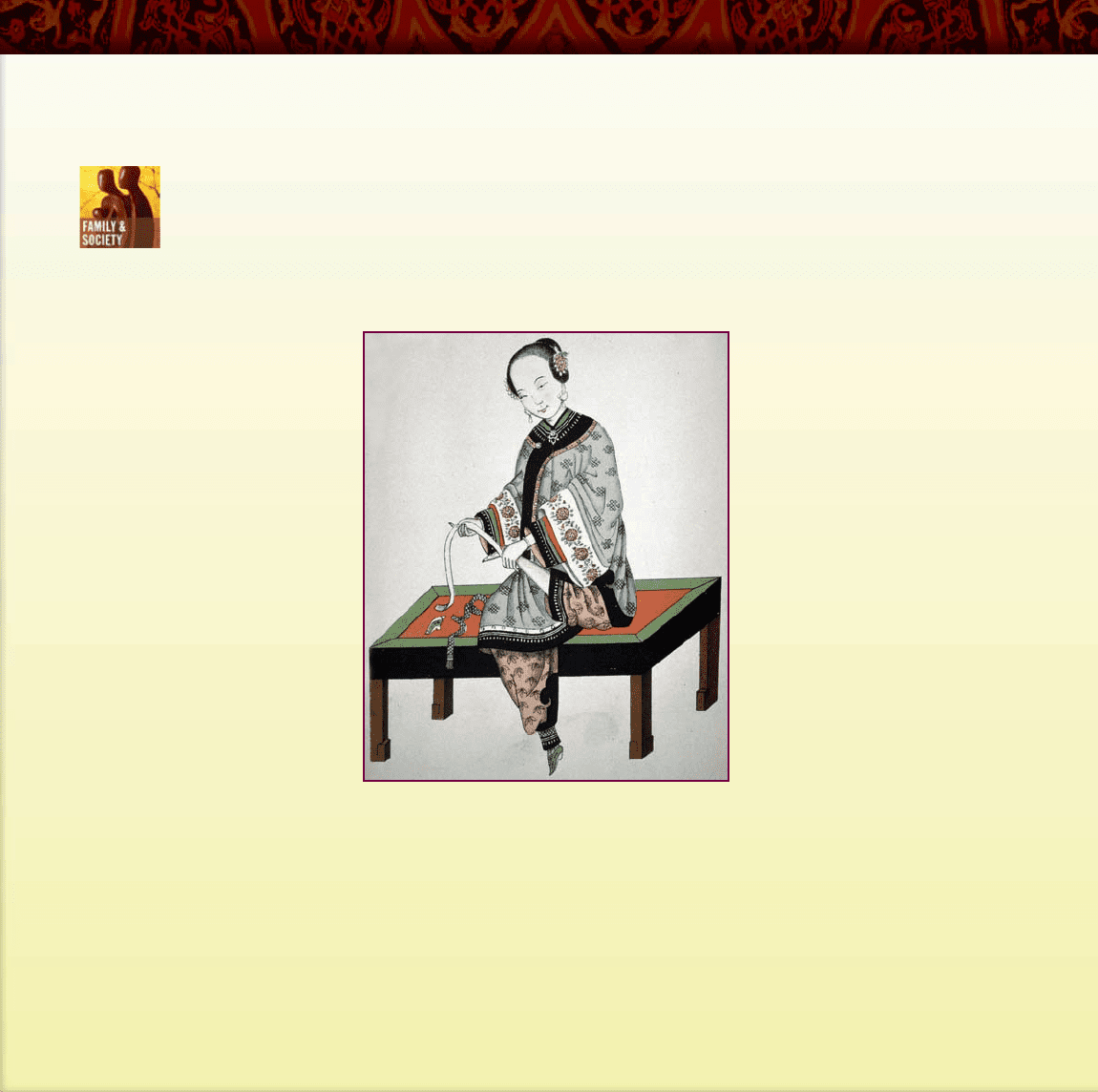
gearing up to challenge the prevailing wisdom. On the
left, a Marxist labor movement began to take shape in the
early 1920s in response to growing economic difficulties.
On the right, ultranationalist groups called for a rejection
of Western models of development and a more militant
approach to realizing national objectives.
This cultural conflict between old and new, native
and foreign, was reflected in literature. Japanese self-
confidence had been restored after the victories over
China and Russia and launched an age of cultural crea-
tivity in the early twentieth century. Fascination with
Western literature gave birth to a striking new genre
COMPARATIVE ESSAY
O
UT OF THE DOLL’S HOUSE
In Henrik Ibsen’s play A Doll’s House, published
in 1879 and excerpted on page 503, Nora Helmer
informs her husband, Torvald, that she will no
longer accept his control over her life and an-
nounces her intention to leave home to start her life anew.
When the outraged Torvald cites her sacred duties as
wife and mother, Nora replies that
she has other duties just as sacred,
those to herself. ‘‘I can no longer
content myself with what most peo-
ple say,’’ she declares. ‘‘I must
think over things for myself and get
to understand them.’’
To Ibsen’s contemporaries, such r emarks
were revolutionary . In nineteenth-
century Europe, the traditional charac-
terization of the sexes, based on gender-
defined social roles, had been elevated
to the status of a universal law. As the
family wage earners, men were expected
to go off to work, while women were
assigned the responsibility of caring for
home and family. Women were advised
to accept their lot and play their role as
effectively and as gracefully as possible.
In other parts of the world, women
generally had even fewer rights in com-
parison with their male counterparts.
Often, as in traditional China, they
were viewed as a sex object.
The ideal, however, did not always match reality. With the ad-
vent of the Industrial Revolution, many women, especially those
from the lower classes, were driven by the need for supplemental in-
come to seek employment outside the home, often in the form of
menial labor. Some women, inspired by the ideals of human dignity
and freedom expressed during the Enlightenment and the French
Revolution, began to protest against a tradition of female inferiority
that had long kept them in a ‘‘doll’s house’’ of male domination and
to claim equal rights before the law.
The movement to liberate women from the iron cage of legal
and social inferiority first began to gain ground in English-speaking
countries such as Great Britain and the United States, but it gradu-
ally spread to the continent of Europe and then to colonial areas
in Africa and Asia. By the first decades of the twentieth century,
women’s liberation movements were under way in parts of North
Africa, the Middle East, and East Asia,
voicing a growing demand for access
to education, equal treatment before
the law, and the right to vote. No-
where was this more the case than in
China, where a small minority of edu-
cated women began to agitate for
equal rig hts with men.
Progress, however, was often
agonizingly slow, es pecially in socie-
ties where age-old traditio nal values
had not yet been undermined by the
corrosive force of the Industrial Revo-
lution. In many colonial societies, the
effort to improve the condition of
women was subordinated to the goal
of gaining nation al independence. In
some instances, women’s liberation
movements were led by educated
elites who failed to include the con-
cerns of working-class women in their
agendas. Colonialism, t oo, was a
double-edged sword, as the sexist bias
of Europe an officials combined with
indigenous traditions of male superi-
ority to marginalize women even further. As men moved to the
cities to exploit opportunities provided by the new colonial admin-
istra tion, women were left to cope with the ir traditional responsibil-
ities in the villages, often without the safety net of male support
that had sustained them during the precolonial era.
Q
From the information available to you, do you believe that
the imperialist policies applied in colonial territories served to
benefit the cause of women’s rights or not?
The Chinese ‘‘Doll’s House.’’ A woman in traditional
China binding her feet
c
The Art Archive/Marc Charmet
JAPA N BETWEEN THE WARS 607
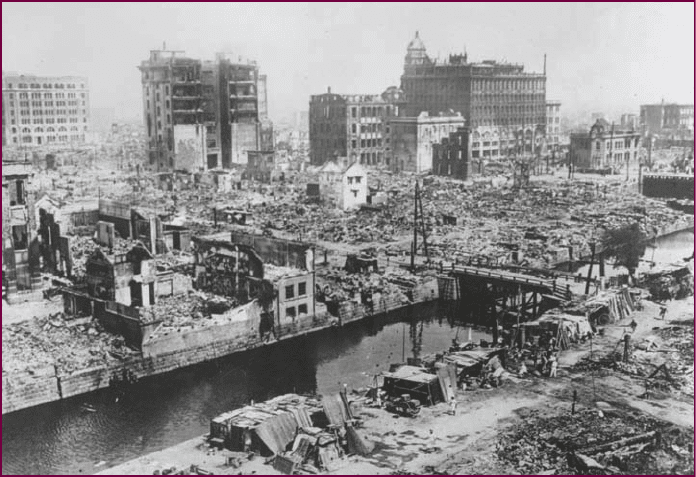
called the ‘‘I novel.’’ Defying traditional Japanese reti-
cence, some authors reveled in self-exposure with con-
fessions of their innermost thoughts. Others found release
in the ‘‘proletarian literature’’ movement of the early
1920s. Inspired by Soviet literary examples, these authors
wanted literature to serve socialist goals in order to im-
prove the lives of the working class. Finally, some Japanese
writers blended Western psychology with Japanese sensi-
bility in exquisite novels reeking with nostalgia for the old
Japan. One well-known example is Junichiro Tanizaki’s
Some Prefer Nettles, published in 1929, which delicately
juxtaposed the positive aspects of both traditional and
modern Japan. By the 1930s, however, military censorship
increasingly inhibited free literary expression.
A Zaibatsu Economy
Japan also continued to make impressive progress in
economic development. Spurred by rising domestic de-
mand as well as continued government investment in the
economy, the production of raw materials tripled between
1900 and 1930, and industrial production increased more
than twelvefold. Much of the increase went into exports,
and Western manufacturers began to complain about
increasing competition from the Japanese.
As often happens, rapid industrialization was ac-
companied by some hardship and rising social tensions.
In the Meiji model, various manufacturing processes were
concentrated in a single enterprise, the zaibatsu, or fi-
nancial clique. Some of these firms were existing mer-
chant companies that had the capital and the foresight to
move into new areas of opportunity. Others were formed
by enterprising samurai, who used their status and ex-
perience in management to good account in a new en-
vironment. Whatever their origins, these firms, often with
official encouragement, gradually developed into large
conglomerates that controlled a major segment of the
Japanese economy. By 1937, the four largest zaibatsu
(Mitsui, Mitsubishi, Sumitomo, and Yasuda) controlled
21 percent of the banking industry, 26 percent of mining,
35 percent of shipbuilding, 38 percent of commercial
shipping, and more than 60 percent of paper manu-
facturing and insurance.
This concentration of power and wealth in a few major
industrial combines created problems in Japanese society.
In the first place, it resulted in the emergence of a dual
economy: on the one hand, a modern industry character -
ized by up-to-date methods and massive gov ernment
subsidies, and on the other, a traditional manufacturing
sector characterized by conservative methods and small-
scale production techniques.
Concentration of wealth also led to growing eco-
nomic inequalities. As we have seen, economic growth
had been achieved at the expense of the peasants, many of
whom fled to the cities to escape rural poverty. That labor
surplus benefited the industrial sector, but the urban
proletariat was still poorly paid and ill-housed. A rapid
increase in population (the total population of the
Japanese islands increased from an estimated 43 million
in 1900 to 73 million in 1940) led to food shortages and
the threat of rising unemployment. In the meantime,
those left on the farm continued to suffer. As late as the
The Great Tokyo Earthqu ake. On
September 1, 1923, a massive earthquake
struck the central Japanese island of
Honshu, causing more than 130,000 deaths
and virtually demolishing the capital city of
Tokyo. Though the quake was a national
tragedy, it also came to symbolize the
ingenuity of the Japanese people, whose
efforts led to a rapid reconstruction of the
city in a new and more modern style.
That unity of national purpose would be
demonstrated again a quarter of a century
later in Japan’s swift recovery from the
devastation of World War II.
c
Getty Images
608 CHAPTER 24 NATIONALISM, REVOLUTION, AND DICTATORSHIP

beginning of World War II, an estimated one-half of all
Japanese farmers were tenants.
Shidehara Diplomacy
A final problem for Japanese leaders in the post-Meiji
era was the familiar dilemma of finding sources of raw
mate rials and foreign markets for the nation’s manu-
fact ured goods. Until World War I, Japan had dealt wit h
the problem by seizing territ ories such as Taiwan, Korea,
and southern Manchuria and trans forming them int o
colonies or protectorates of the growing Japanese em-
pire. That policy had begun to arouse the concern, and
in some cases the hostility, of the Western nations. China
was also becoming apprehensive; as we have seen,
Japanese demands for Shandong Province at the Par is
Peace Conference in 1919 aroused massive protests in
major Chinese cities.
The United States was especially concerned about
Japanese aggressivenes s. Although the United Sta tes had
been less ac tive than some European states in pursuing
colonies in the Pacific, it had a strong interest in keeping
the area open for U.S. commercial activities. In 1922, in
Washington, D.C ., the United Sta tes convened a major
conference of nations with interests in the Pacific to
discuss problems of region al security. The Washington
Conference led to agreements on several issues, but the
major accomplishment was a nine-power treaty recog-
nizing the territorial integrity of China and the Open
Door. The other participants induced Japan to accept
these provisions by accepting its speci al position in
Manchuria.
During the remainder of the 1920s, Japanese gov-
ernments attempted to play by the rules laid down at the
Washington Conference. Known as Shidehara diplomacy,
after the foreign minister (and later prime minister) who
attempted to carry it out, this policy sought to use dip-
lomatic and economic means to realize Japanese interests
in Asia. But this approach came under severe pressure as
Japanese industrialists began to move into new areas,
such as heavy industry, chemicals, mining, and the
manufacturing of appliances and automobiles. Because
such industries desperately needed resources not found in
abundance locally, the Japanese government came under
increasing pressure to find new sources abroad.
In the early 1930s, with the onset of the Great
Depression and gr owing tensions in the international
arena, nationalist forces rose to dominance in the gov-
ernment. Wher eas party leaders during the 1920s had at-
tempted to r ealize Japanese aspirations within the existing
global political and economic framework, the dominant
elements in the government in the 1930s, a mixture of
military officers and ultranationalist politicians, were
con vinced that the diplomacy of the 1920s had failed; they
advocated a mor e aggressive approach to protecting na-
tional interests in a brutal and competitive world.
(see Chapter 25).
Nationalism and Dictatorship
in Latin America
Q
Focus Questions: What problems did the nations of
Latin America face in the interwar years? To what
degree were they a consequence of foreign influence?
Although the nations of Latin America played little role in
World War I, that conflict nevertheless exerted an impact
on the region, especially on its economy. By the end of the
1920s, the region was also strongly influenced by another
event of global proportions---the Great Depression.
A Changing Economy
At the beginning of the twentieth century, virtually all of
Latin America, except for the three Guianas, British
Honduras, and some of the Caribbean islands, had
achieved independence (see Map 24.2). The economy of the
region was based largely on the export of foodstuffs and
raw materials. Some countries relied on exports of only
one or two products. Argentina, for example, exported
primarily beef and wheat; Chile, nitrates and copper;
Brazil and the Caribbean nations, sugar; and the Central
American states, bananas. A few reaped large profits from
these exports, but for the majority of the population, the
returns were meager.
The Role of the Yankee Dollar World War I led to a
decline in European investment in Latin America and a
rise in the U.S. role in the local economies. By the late
1920s, the United States had replaced Great Britain as
the foremost source of investment in Latin America.
Unlike the British, however, U.S. investors put their
funds directly into production enterprises , causing large
segments of the area’s export industries to fall into
American hands. A number of Central American states,
for exa mple, were popul arly labeled ‘‘banana republics’’
because of the power and influence of the U.S.-owned
United Fruit Company. American firms also dominated
the copper mining industry in Chile and Peru and the oil
industry in Mexico, Peru, and Bolivia.
The Effects of Dependence
During the late nineteenth century, most governments
in Latin America had been increasingly dominated by
NATIONALISM AND DICTATORSHIP IN LATIN AMERICA 609
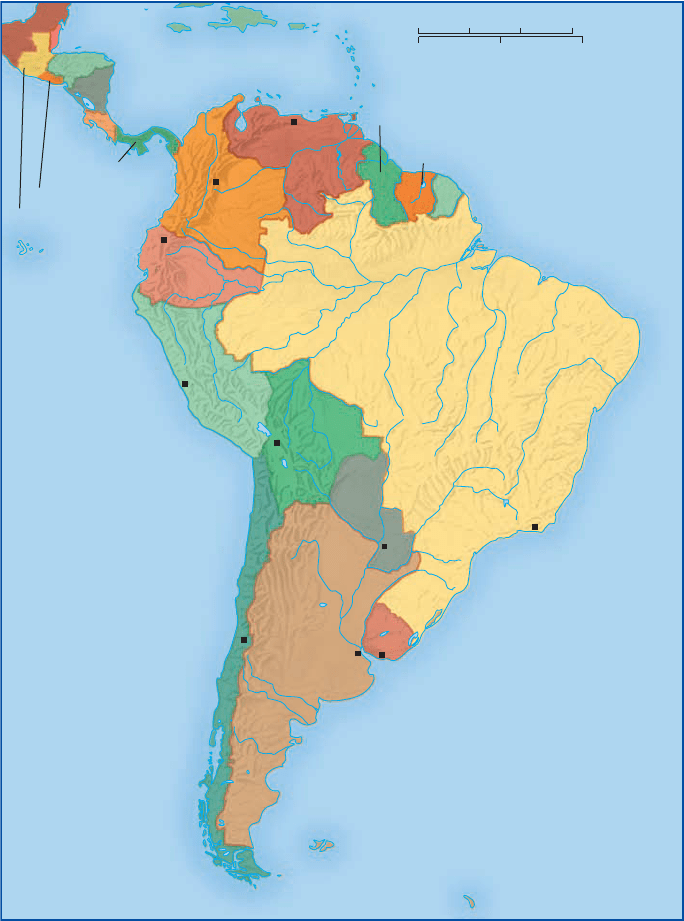
landed or military elites, who controlled the mass of the
population---mostly impoverished peasants---by the bla-
tant use of military force. This trend toward authoritar-
ianism increased during the 1930s as domestic instability
caused by the effects of the Great Depression led to the
creation of dictatorships throughout the region. This
trend was especially evident in Argentina and Brazil
and to a lesser degree in Mexico---three countries that
together possessed more than half
of the land and wealth of Latin
America.
Argentina The political domi-
nation of Argentina by an elite
minority often had disastrous ef-
fects. The Argentine government,
controlled by landowners who had
benefited from the export of beef
and wheat, was slow to recognize
the growing importance of estab-
lishing a local industrial base. In
1916, Hip
olito Irigoyen (1852--
1933), head of the Radical Party,
was elected president on a pro-
gram to improve conditions for
the middle and lower classes. Little
was achieved, however, as the
party became increasingly corrupt
and drew closer to the large
landowners. In 1930, the army
overthrew Irigoyen’s government
and reestablished the power of the
landed class. But their efforts to
return to the previous export
economy and suppress the grow-
ing influence of the labor unions
failed.
Brazil Brazil followed a similar
path. In 1889, the army over-
threw the Brazilian monarchy,
installed by Portugal years before,
and established a republic. But
it was dominated by landed
elites, many of whom had grown
wealthy through their ownership
of coffee plantations. By 1900,
three-quarters of the world’s
coffee was grown in Brazil. As in
Argentina, the ru ling oligarchy
ignored the impor tance of es-
tablishing an ur ban industrial
base. When the Great Depression
ravaged profits from coffee exports, a wealthy rancher,
Get
ulio Va rgas (1883--1954), seized power and ruled the
country as president from 1930 to 1945. At first, Vargas
sought to appease workers by declaring an eight-hour
workday and a minimum wage, but, influenced by the
ap parent success of fascist regimes in Europe, h e ruled
by increasing ly autocratic means and relied on a police
force that used torture to silence his opponents.
South
Atlantic
Ocean
South
Pacific
Ocean
North
Atlantic
Ocean
C
a
r
i
b
b
e
a
n
Sea
Rio de
Janeiro
Falkland
Islands (U.K.)
South Georgia
Island (U.K.)
Buenos
Aires
Santiago
Montevideo
Quito
Bogotá
Caracas
Lima
Asunción
La Paz
BRAZIL
BOLIVIA
PERU
COLOMBIA
GUATEMALA
EL SALVADOR
PANAMA
COSTA
RICA
NICARAGUA
HONDURAS
BRITISH HONDURAS
MEXICO
ECUADOR
VENEZUELA
PARAGUAY
CHILE
ARGENTINA
URUGUAY
FRENCH
GUIANA
BRITISH
GUIANA
DUTCH
GUIANA
0 500 1,000 Miles
0 500 1,000 1,500 Kilometers
MAP 24.2 Latin A merica in the First Half of the Twentieth Cen tury. Shown here
are the boundaries dividing the countries of Latin America after the independence
movements of the nineteenth century.
Q
Which areas r emained under E uropean rule?
610 CHAPTER 24 NATIONALISM, REVOLUTION, AND DICTATORSHIP

His industrial policy was relatively enlightened, how-
ever, and by the end of World War II, Brazil had become
Latin America’s major industrial power. I n 1945, the
army, fearing that Vargas might prolong his power il-
legally after calling for new elections, forced him to
resign.
Mexico Mexico, in the early years of the new century,
was in a state of turbulence. Under the rule of dictator
Porfirio D
ıaz (see Chapter 20), the real wages of the
working class had declined. Moreover, 95 percent of the
rural population owned no land, and about a thousand
families ruled almost all of Mexico. When a liberal
landowner, Francisco Madero, forced D
ıaz from power
in 1910, he opened the door to a wider revolution.
Madero’s ineffectiveness triggered a dema nd for agrar-
ian reform led by Emiliano Zapata (1879--1919), who
arousedthemassesoflandlesspeasantsinsouthern
Mexico and began to seize the haciendas of wealthy
landholders.
For the next several years, Zapata and rebel leader
Pancho Villa (1878--1923), who operated in the northern
state of Chihuahua, became an important political force
in the country by publicly advocating efforts to redress
the economic grievances of the poor. But neither had a
broad grasp of the challenges facing the country, and
power eventually gravitated to a more moderate group of
reformists around the Constitutionalist Party. The latter
were intent on breaking the power of the great landed
families and U.S. corporations, but without engaging in
radical land reform or the nationalization of property.
After a bloody conflict that cost the lives of thousands, the
moderates consolidated power, and in 1917, they pro-
mulgated a new constitution that established a strong
presidency, initiated land reform policies, established
limits on foreign investment, and set an agenda for social
welfare programs.
In 1920, Constitutionalist leader Alvaro Obreg
on
assumed the presidency and began to carry out his re-
form program. But real change did not take place until
the presidency of General L
azaro C
ardenas (1895--1970)
in 1934. C
ardenas won wide popularity with the peas-
ants by ordering the redistribution of 44 million acres of
land controlled by landed elites. He also seized con trol
of the oil industry, which had hitherto been dominated
by major U.S. oil companies. Alluding to the Good
Neighbor policy, President Roosevelt refused to inter-
vene, and eventu ally Mexico agreed to compensat e U.S.
oil companies for their lost propert y. It then set up
PEMEX, a governmental organization, to run the oil
industry.
Latin American Culture
The first half of the twentieth century witnessed a dra-
matic increase in literary activity in Latin America, a re-
sult in part of its ambivalent relationship w ith Europe and
the United States. Many authors, while experimenting
with imported modernist styles, felt compelled to pro-
claim Latin America’s unique identity through the
adoption of native themes and social issues. In The
Underdogs (1915), for example, Mariano Azuela (1873--
1952) presented a sympathetic but not uncritical portrait
of the Mexican Revolution as his country entered an era
of unsettling change.
In their determination to commend Latin America’s
distinctive characteristics, some writers extolled the
promise of the region’s vast virgin lands and the di-
versity of its peoples. In Don Segundo Sombra, published
in 1926, Ricardo Guiraldes (1886--1927) celebrated the
life of the ideal gaucho (cowboy), d efining Argentina’s
hope and strength through the enlightened manage-
ment of its fertile earth. Likewise, in Dona Barbara,
R
omulo Gallegos (1884--1969) wrote in a similar vein
about his native Venezuela. Other authors pursued
the theme of solitude and detachment, a product of
the region’s physical separation from the rest of the
world.
Latin American artists followed their literary
counterparts in joining the Modernist movement in
Euro pe, yet they too were eager to promote the emer-
gence of a new regional and national essence. In
Mexico, where the government provided financial
support for painting murals on public buildings, the
artist Diego Rivera (1886--1957) began to produce a
monumental style of mural art that served two pur-
poses: to illustrate the national past by portraying
Aztec legends and folk customs and to popularize a
political message in favor of realizing the social goals of
the Mexican Revolution. His wife, Frida Kahlo (1907--
1954), incorporated Surrealist whimsy in her ow n
paintings, many of which were portraits of herself and
her family.
CHRONOLOGY
Latin America Between the Wars
Hip
olito Irigoyen becomes president
of Argentina
1916
Argentinian military overthrows Irigoyen 1930
Rule of Get
ulio Vargas in Brazil 1930--1945
Presidency of L
azaro C
ardenas in Mexico 1934--1940
Beginning of Good Neighbor policy 1935
N
ATIONALISM AND DICTATORSHIP IN LATIN AMERICA 611
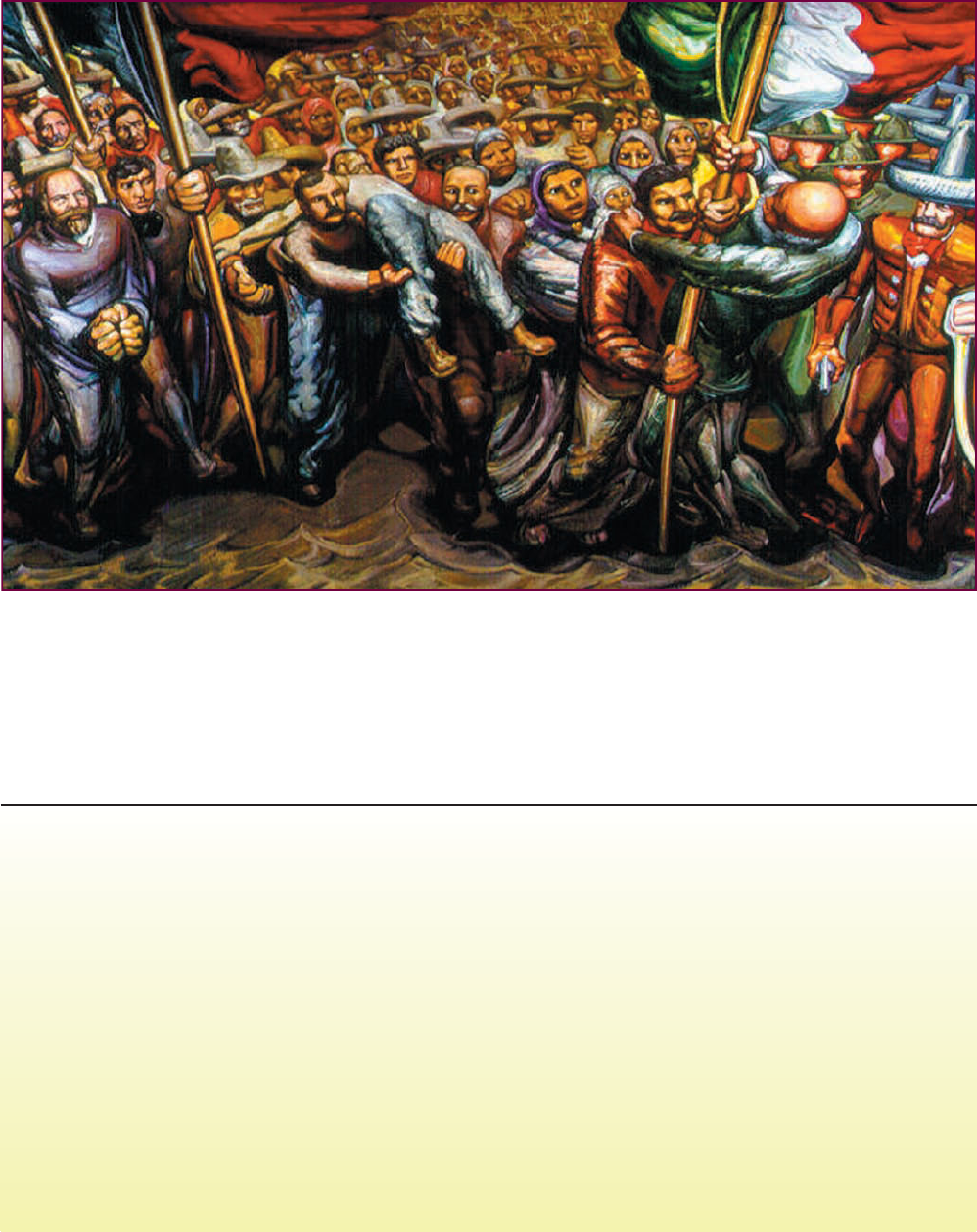
Struggle for the Banner. Like Diego Rivera, David Alfaro Siqueiros (1896–1974) adorned public buildings
with large murals that celebrated the Mexican Revolution and the workers’ and peasants’ struggle for freedom.
Beginning in the 1930s, Siqueiros expressed sympathy for the exploited and downtrodden peoples of Mexico in
dramatic frescoes such as this one. He painted similar murals in Uruguay, Argentina, and Brazil and was once
expelled from the United States, where his political art and views were considered too radical.
CONCLUSION
THE TURMOIL BROUGHT about by World War I not only
resulted in the destruction of several of the major Western empires
and a redrawing of the map of Europe but also opened the door to
political and social upheavals elsewhere in the world. In the Middle
East, the decline and fall of the Ottoman Empire led to the creation
of the secular republic of Turkey. The state of Saudi Arabia emerged
in the Arabian peninsula, and Palestine became a source of tension
between newly arrived Jewish immigrants and longtime Muslim
residents.
Other parts of Asia and Africa also witnessed the rise of
movements for national independence. In Africa, these movements
were spearheaded by native leaders educated in Europe or the
United States. In India, Gandhi and his campaign of civil
disobedience played a crucial role in his country’s bid to be free of
British rule. Communist movements also began to emerge in Asian
societies as radical elements sought new methods of bringing about
the overthrow of Western imperialism. Japan continued to follow its
own path to modernization, which, although successful from an
economic point of view, took a menacing turn during the 1930s.
Between 1919 and 1939, China experienced a dramatic
struggle to establish a modern nation. Two dynamic political
organizations---the Nationalists and the Communists---competed for
legitimacy as the rightful heirs of the old order. At first, they formed
an alliance in an effort to defeat their common adversaries, but
cooperation ultimately turned to conflict. The Nationalists under
Chiang Kai-shek emerged supreme, but Chiang found it difficult to
control the remnants of the warlord regime in China, while the
Great Depression undermined his efforts to build an industrial
nation.
During the interwar years, the nations of Latin America faced
severe economic problems because of their dependence on exports.
Increasing U.S. investments in Latin America contributed to
growing hostility toward the powerful neighbor to the north. The
Great Depression forced the region to begin developing new
c
2008 Artists Rights Society (ARS), NY/SOMAAP, Mexico City//Digital image
c
Schalwijk/Art Resource, NY
612 CHAPTER 24 NATIONALISM, REVOLUTION, AND DICTATORSHIP
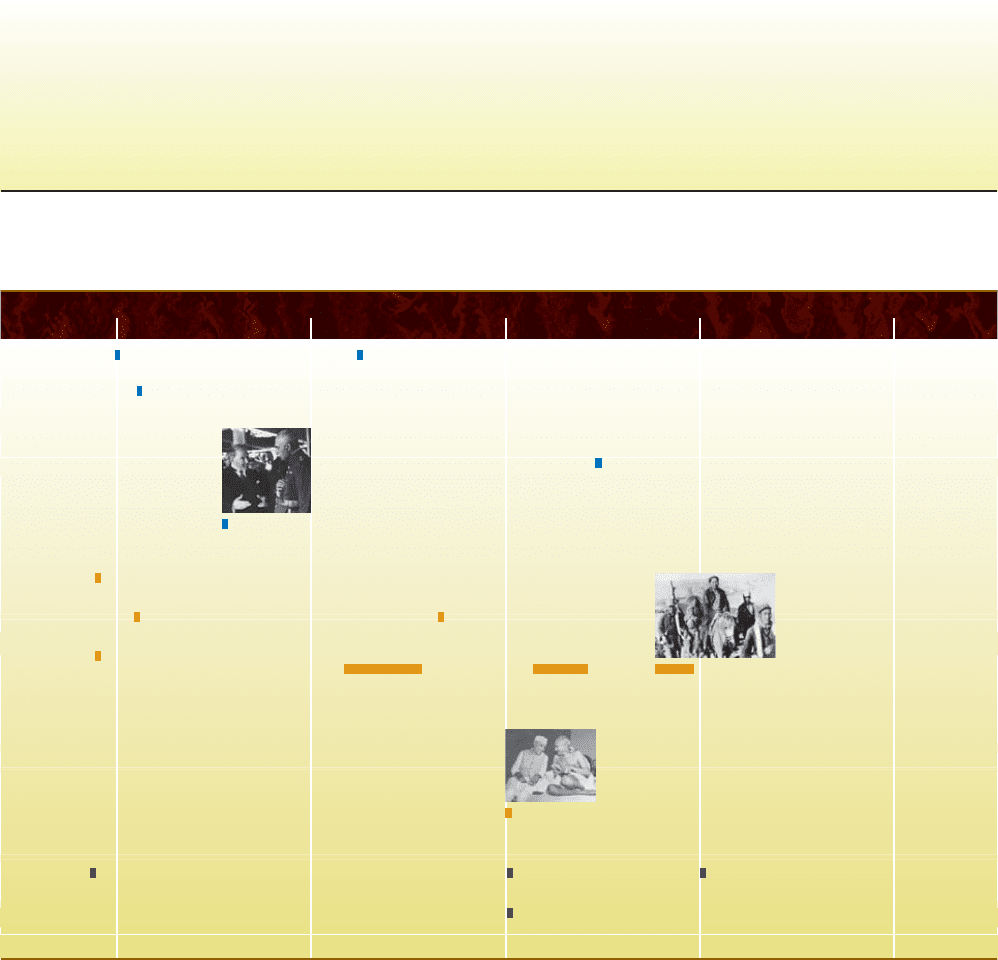
SUGGESTED READING
Nationalism The clas sic study of nationalism in the non-
Western world is R. Emerson, From Empire to Nation (Boston,
1960). For a more recent approach, see B. Anderson, Imagined
Communities: Reflections on the Origin and Spread of Nationalism
(London, 1983). On nationalism in India, see S. Wolpert, Congress
and Indian Nationalism: The Pre-Independence Phase (New York,
1988). Also see P. Chatterjee, The Nation and Its Fragments:
Colonial and Postcolonial Histories (Princeton, N.J., 1993), and
E. Gellner, Nations and Nationalism (Ithaca, N.Y., 1994).
Gandhi There have been a number of studies of Mahatma
Gandhi and his ideas. See, for example, S. Wolpert, Gandhi’s
Passion: The Life and Legacy of Mahatma Gandhi (Oxford, 1999),
and D. Dalton, Mahatma Gandhi: Nonviolent Power in Action
(New York, 1995). For a study of Nehru, see J. M. Brown, Nehru
(New York, 2000).
Middle East For a general survey of events in the Middle East
in the interwar era, see E. Bogle, The Modern Middle East: From
Imperialism to Freedom (Upper Saddle River, N.J., 1996). For more
specialized studies, see I. Gershoni et al., Egypt, Islam, and the
TIMELINE
1920
1925 1930 1935 1940
Middle
East
Asia
Latin
America
Reza Khan seizes power in Iran
Formation of Chinese Communist Party
Formation of Comintern
American Good Neighbor policy beginsVargas takes power in Brazil
Northern Expedition
in China
Creation of Nanjing Republic
The Long March
Creation of Turkey under Atatürk
Ibn Saud establishes Saudi Arabia
May Fourth Movement
New constitution in Mexico
Gandhi’s march to the sea
Army seizes power in Argentina
Rise of militant
government in
Japan
British mandate in Iraq Discovery of oil
in Iraq
industries, but it also led to the rise of authoritarian governments,
some of them modeled after the fascist regimes of Italy and
Germany.
By demolishin g the remnants of their old civilization on
the battlefields of World War I, Europeans had inadvertently
encouraged the subject peoples of their vast colonial empires
to begin their own movements for national independence.
The process was by no means completed in the two decades
following t he Treaty of Versailles, but the bonds of imperial rule
had been severely strained. Once Europeans began to weaken
themselves in the even more destructive conflict of World War II,
the hopes of African and Asian peoples for national independence
and freedom could at last be realized. It is to that devastating world
conflict that we now turn.
CONCLUSION 613
